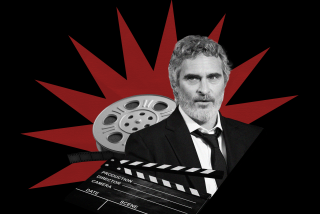It’s Time to Out Gay Stereotyping in Films
Never before have there been so many explicitly gay characters appearing in American films. This is a striking cultural phenomenon that has occurred almost completely undocumented by the Los Angeles Times and in particular by The Times’ lead film critic, Kenneth Turan.
Whether it’s “American Beauty” or “The Talented Mr. Ripley,” filmmakers seem to be struggling between an increasing fascination with gay themes and a continued reliance on negative gay stereotypes. In light of these developments, Turan’s almost complete silence on the subject feels like a serious omission or perhaps even a deliberate avoidance.
As documented in the book and film “The Celluloid Closet,” Hollywood has for decades relied upon simplistic gay characters to play its villains or provide comic relief. The treatment of gays in today’s films is far more complex, and yet so many filmmakers still end up relying on negative stereotypes. In a deceptive twist on tradition, many recent films seem to attempt a politically correct
“balance” between negative gay caricatures and more “positive” views of gay people, but in most cases the balancing act ultimately fails, and we are left with hateful images of gay people as murderers or fools.
Many of these issues can be seen clearly in the movie “American Beauty.” As Turan writes in his Times review (Sept. 15, 1999), this is indeed a “very accomplished film” and even features a screenplay written by a gay man. The film’s central character, a heterosexual husband and father, discovers his individuality in a significant new way through awareness of forbidden sexuality.
Many gay viewers of the film immediately recognize this journey as a thinly veiled “coming out” story transferred onto a straight character. How unsettling, then, that the film’s explicitly gay characters are so negatively portrayed.
The film’s plot is in fact hinged on the stereotypical actions of a closeted, self-hating ex-Marine who must murder the straight man who rejects him after he finally makes a sexual advance.
Was the film trying to balance this negative stereotype of the “gay murderer” with the “positive” portrayal of a super-suburban happy gay couple? If so, it’s a failure. This cardboard couple merely provide a few moments of comic relief, much as gay men have often done for films, and is long forgotten by the time we learn that the film’s villain is secretly gay and blood is splattered across the screen.
Turan completely misses similar themes in his review of “The Talented Mr. Ripley” (Dec. 24, 1999). Instead, he weirdly suggests that the main character’s gay identity should have been kept “just under the surface,” for improved dramatic tension. Turan writes nothing about the cultural significance of a major release featuring a central gay character, and he seems equally oblivious to the film’s reliance on negative gay stereotypes.
*
Just as the character Ripley seduces his friends into believing he’s someone he’s not, so the movie “Ripley” seduces us into identifying with the main character, because Matt Damon’s portrayal is initially so believable and even sympathetic. Yet as the story progresses, the character becomes more and more pathological and, by the end, has been reduced to the hollow, evil stereotype of the “gay murderer.”
The “positive” gay character, Tom Ripley’s final love interest, is also destroyed in this descent, repeating another Hollywood stereotype: the gay fool who gets killed for daring to love another man.
Perhaps it was inevitable that these half-hearted attempts at “political correctness” would fail, since they appear to be rooted in a largely unconscious love-hate relationship with gay themes. What’s needed instead is a quantum leap in understanding about the deeper meaning and purpose of gayness.
I challenge Turan and his colleagues to explore why the machinery that produces culture in America is ever more fascinated with gay characters and yet still so determined to undermine gay people with the insidious use of negative stereotypes.
What could be so threatening to the status quo to warrant such distortions of our actual being? Perhaps it is the unyielding way in which gay men and lesbians must challenge inherited familial, cultural and religious values in order to “come out” as gay.
It seems to me that the freeing of the individual from unexamined group norms and constraints is the most subversive and dangerous philosophy anyone could embody, even in a so-called “democracy.”
As our society becomes more and more ruled by corporate-mindedness, it makes sense that gay people--embodying authentic individuality--would become increasingly inspiring and also frightening for filmmakers in search of compelling characters. But until these conflicting issues are more seriously addressed, it’s likely that the cruel twisting of gay characters and themes in film will continue.
More to Read
Only good movies
Get the Indie Focus newsletter, Mark Olsen's weekly guide to the world of cinema.
You may occasionally receive promotional content from the Los Angeles Times.










